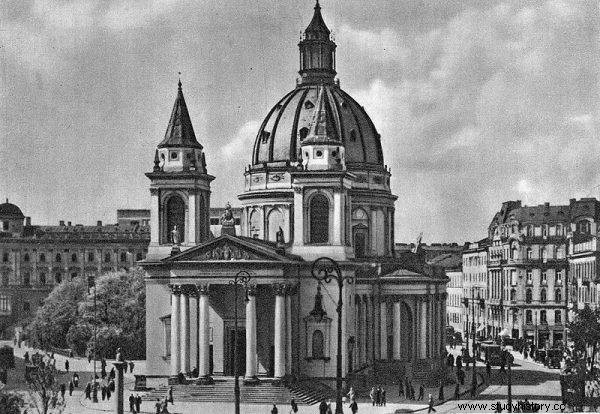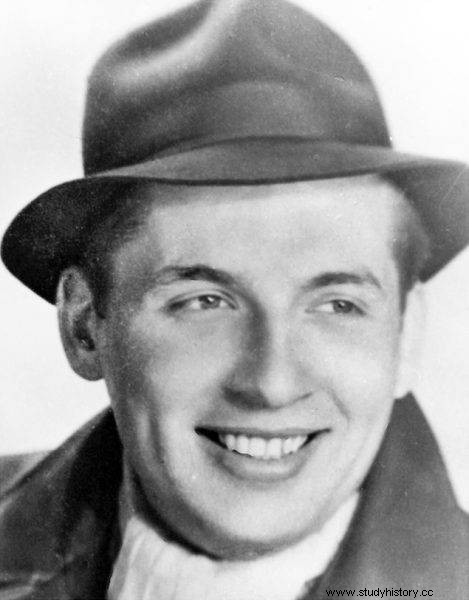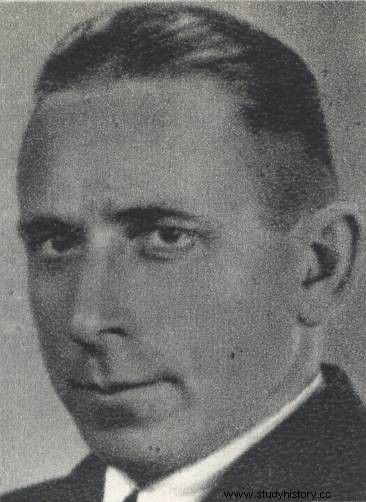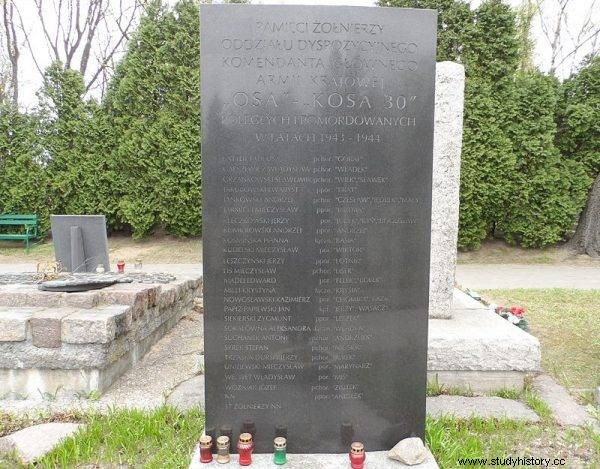This error shocked the Polish Underground State. On June 5, 1943, at high noon, several dozen soldiers of the selected KOSA - a division of the Home Army for special tasks - went to a friend's wedding at the church of St. Aleksandra in the center of Warsaw. For the Germans it was like an invitation. They could not miss such an opportunity. During the ceremony, all participants were arrested by the Gestapo. Many of them were going to die.
In 1942, as part of the Home Army, a select OSA was established - the Special Organization for Combat Actions (later renamed KOSA 30), whose task was, among others, carrying out attacks on particularly dangerous Nazis, executing death sentences, combat and even terrorist actions - in the very heart of the Reich, i.e. in Berlin. Bombs at the courts in Berlin were planted by the KOSA unit called Zagra-Lin.
Due to the specific nature of its activities, KOSA had a lot of autonomy compared to other AK cells. She was also heavily conspiratorial.
At the wedding carpet
On June 5, 1943, at noon in the church of St. Alexander at Plac Trzech Krzyży in Warsaw, the wedding of KOSA soldier Mieczysław Uniejewski with Teofila Suchanek has begun. The ceremony was attended by 25 KOSA soldiers, families of both sides, invited guests, bystanders. How did the command agree to participate in the wedding of so many underground soldiers? This is one of the riddles of the largest "dump" in the history of the Home Army.
The consent was given by the commander of KOSA 30, Lt. Col. Józef Szajewski pseud. Philips. Only Zagra-Lin soldiers, professionals carrying out bomb attacks abroad, smelled the writing. Despite the invitations, none of them showed up at the wedding. Years later it turned out that even the boys serving the mass knew that the underground people were taking part in the ceremony.

St. Alexander in Warsaw (pre-war appearance), place where the troops of the detachment were arrested.
While a couple in love uttered the oath and said the sacramental "yes" to each other, the Gestapo cordoned off the church with a tight cordon and lined the side streets. The Germans burst in at the end of the ceremony, as the newlyweds were already departing from the altar. It was a shock to the audience. 89 guests participated in the ceremony. At first, they thought it might be just a round-up. At that time, round-ups in Warsaw were commonplace and there were also churches.
For this reason, and also because of the numerical superiority of the Germans, no one put up any resistance. KOSA's soldiers had well-forged documents, they could count on surviving the interrogations. The ceremony, instead of congratulations, a celebration of the bride and groom and confetti, ended with taking the participants to the Gestapo trucks that were waiting for them outside.
End of BOWS
It quickly became clear that this was not a random roundup. The Germans knew perfectly well who they were detaining, and the action was carefully planned. In Pawiak, the Gestapo "weeded out" wedding guests who had nothing to do with the underground from Home Army soldiers. The former were released home. Others faced brutal torture. During the interrogations, among others, Aleksander Sokalówna's liaison officer . She has not released anyone. In her cell, she committed suicide by swallowing a cyanide pill.

Thanks to searches in the homes of the detained, the Germans found the perpetrators of the recent, unsuccessful attack in Krakow - Friedrich Wilhelm Krüger,
Thanks to searches in the homes of the detained, the Germans found the perpetrators of the recent, unsuccessful attack in Krakow - Friedrich Wilhelm Krüger, a war criminal, SS and Police commander in the General Government. Attack participant, Tadeusz Battek ps. The highlander, during the torture, confessed to everything and revealed the other names.
Many participants of the ill-fated wedding were shot. The groom - Mieczysław Uniejewski - was shot in the ruins of the Warsaw ghetto. His newly married wife and parents were sent to the Auschwitz-Birkenau extermination camp. In the death camp, however, they managed to survive the war.
Traitor "Hel"?
The great "chute" in the church of St. Aleksandra was the end of KOSA. The branch was not reactivated anymore. For this reason, Zagra-Lin, a selected cell that organized bomb attacks in the Reich (including Berlin and Breslau), had also ended its activity. The soldiers of this unit remained elusive for the Germans until the end of the war.
To this day, historians and enthusiasts of the history of the Polish Underground State are asking themselves how it happened that permission was given for such a carefree ceremony, and whether there was a traitor behind the island . 25 years after the war, Aleksander Kunicki "Rayski", former intelligence chief of OSA - KOSY added fuel to the fire in this matter. In 1971 his book Silent Front was published . It was on her cards that the name of the alleged traitor appeared.

Stanisław Jaster ps. "Hel"
It was supposed to be a certain Stanisław Jaster pseudonym "Hel" - during these events a 22-year-old KOSA soldier, appreciated by the command, famous for his courage, experienced in combat operations. According to Kunicki, Jaster confessed to treason and paid the highest price with it - a death sentence was carried out on him. He was supposed to be an informer from the very beginning of his activity in the underground. In 1940, during a round-up, Stanisław Jaster was captured and taken to Auschwitz-Birkenau. There, he was to accept the German offer - he would be released, but he would work for the occupier. It was also supposed to happen.
The Gestapo arranged for Jaster to escape. Together with three other prisoners, he stole the SS uniforms and a car, and then in June 1942 - a year before the "dump" in the church, he escaped from the camp. Of course everything was made up by the Germans. After getting to Warsaw, "Hel" easily entered the underground structures and gained the trust of the command . On the day of the ill-fated wedding, he did not appear in the church. He later explained that he overslept.
Serial runaway
It's over for me. Soon after the "pour", the underground received another painful blow. Lieutenant Mieczysław Kudelski, pseudonym. "Wiktor", KOSA's chief executive officer. Immediately after the fatal mishap, Kudelski wanted to recreate the branch. To this end, he met with Jaster (it was he who proposed a meeting). The gentlemen saw each other on June 12, 1943 at 6 p.m. near the corner of ul. Krucza and Nowogrodzka. Suddenly a Gestapo car drove up to them. They were pulled inside and taken to Aleja Szucha.
Soon after, "Hel" returned to the unit, slightly injured in the thigh. He claimed that he managed to escape - he was about to jump out of the German van. However, the gunshot wound was unreliable. Inspection revealed that it was superficial, in addition, the shot was fired at close range, with a 7 mm caliber, while the Gestapo was armed with 9 mm submachine guns. Jaster's account was also undermined by the fact that armed soldiers were always sitting at the door in the vans. In addition, the Home Army counterintelligence was supposed to reach a witness who saw "Hela" leaving the Gestapo headquarters shortly after being arrested and did not even limp.

Mieczysław Kudelski ps. "Wiktor"
According to Kunicki, Jaster, pressed against the wall, finally confessed to everything. It was he who stood behind the "chute" in the church. He did not appear at the ceremony, because the Germans took him to the Pawiak, where he indicated KOSA members from behind the curtain. He was also supposed to stage Kudelski's "Wiktor". As Kunicki wrote "Rayski", there could only be one punishment for a traitor:" A traitor and Gestapo informant, Stanisław Jaster, pseudonym" Hel ", was sentenced to death by a verdict of the Home Army court. The sentence was carried out " .
A year after the publication of the book "Rayski", the Pax Publishing Institute published the memoirs of Emil Kumor pseud. "Chris". In the most important points they confirmed Kunicki's account.
A fatal mistake?
At the time of publication, Kunicki's book sparked controversy in the former underground community, as well as among historians and experts on the subject. The circumstances supporting the version of “Hel” were pointed out, as well as the fact that Kunicki himself was to have access to reports from third parties and did not participate directly in the investigation into the alleged traitor.
It was questioned, inter alia, the alleged act involving the escape of Jaster from Oświęcim. The historian Daria Czarnecka, who published a book on this subject in 2014, had a huge contribution to this ( The case of Stanisław Gustaw Jaster aka "Hel" in historiography. Creation of the image of a traitor and defense ). The documents she obtained for the first time indicate that the Germans undertook an intense pursuit after Jaster's escape from Auschwitz, and the fugitives along with their descriptions were included in the books of the wanted . They were at the disposal of local Gestapo posts. All this contradicts the thesis about the law. Moreover, the consequence of the escape was the arrest of Jaster's parents by the Germans. They both died in Auschwitz.

Plaque in the military Powązki commemorating the fallen and murdered soldiers of OSA - KOSY 30.
It was also pointed out that, contrary to original opinions, the gunshot wound to Jaster's thigh could have been credible. There was also a witness who testified that he saw "Hel" jump out of the van after being arrested together with "Wiktor". In addition - contrary to Kunicki's account - no documents have survived to confirm the fact that the Home Army counterintelligence conducted an investigation into the Jaster case. There are no documents proving that the judgment in this case was issued by the Military Special Court.
For many years, the World Union of Home Army Soldiers refused to rehabilitate Jaster . Officially, it has not yet been found, but in 2019, by the decision of President Andrzej Duda, Stanisław Jaster "Hel" was posthumously awarded the Knight's Cross of the Order of Polonia Restituta. This symbolic gesture will certainly not remove the doubts and the entire list of questions about the underground soldier, who was to turn out to be the occupation's henchman. It is not known how and where he died. Was there really a verdict on him? If there are no traces confirming this fact, maybe he fell victim to lynching or was murdered by the Germans?
The death of Jaster is one of the darkest secrets of the KOSA division of the 30th Home Army, and certainly both it and the accusations against "Hel" will be repeatedly analyzed and searched for.
